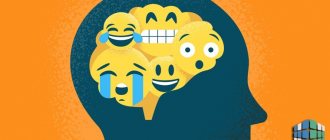In every person, self-regulation of mental activity occurs naturally, i.e. without unnecessary volitional efforts and any actions on his part aimed at relieving tension. However, it often turns out that stress exceeds the protective mechanisms of the psyche, and then it is no longer able to cope with it on its own.
This leads to an incommensurable negative reaction: outbursts of anger, hysterics, aggressiveness, withdrawal, etc. If such a reaction occurs constantly, over time, complete nervous exhaustion of the body occurs, which manifests itself in depression, apathy, persistent low mood, reluctance to do favorite things, decreased interest in life, loss of the ability to enjoy life, inability to build normal relationships with people, isolation and many other negative consequences.
Therefore, today we will talk about how to prevent such pathological conditions and learn to cope with stress on your own, using the best methods of self-regulation.
It is important to note that this article is written for those whose negative emotional states are not severe. If you suffer from severe clinical depression and other emotional spectrum disorders, you may need more advanced stress management techniques, so be sure to reach out to the right professional.
So, from this article you will learn:
- what are negative emotional states;
- how natural self-regulation of states occurs;
- why sometimes our psyche cannot cope with stress on its own;
- in what cases it is necessary to take stress management into your own hands;
- what effective methods of mental self-regulation can be used to eliminate negative states and relaxation.
If you want to take maximum control of your mental states, be sure to enroll in our online Mental Self-Regulation program, which will teach you the most effective techniques for managing your emotions and relaxing.
Let us begin by answering the question of what negative emotional states are and what they are like.
Methodology
To clarify the patterns and features of self-regulation in everyday life, an empirical study was conducted in which respondents described their daily state and methods of regulating it. The survey involved 180 people of the middle age group, of different genders and professional backgrounds. Features of self-regulation of mental states in the daily cycle of everyday life were studied in two groups of subjects (20 people in each group, age 21–34 years). The first group is students, the second group is employees of a trading company. The subjects were asked to answer questions about negative mental states during the day (every hour) and ways to regulate them.
Vladimir Bekhterev was also interested in psychological states
In recent years, the relevance of such an area as state psychology has grown enormously. It is explainable.
— A lecturer may feel anxious before a report, a student may be happy that he received a high mark in the exam. “Fear, sleep, falling in love are also states,” Alexander Prokhorov gave examples in anticipation of a lecture he gave to students at KFU.
According to him, a state is a complex mental phenomenon that is located between mental processes and properties (processes can be cognitive, motivational, and properties are the character and abilities of a person). When studying the psychology of states, scientists encountered a problem: the methodology that is suitable for studying processes and properties is not suitable for studying states. What is the method to catch the slightest change in state? After all, it can be either very long or very short.
At Kazan University, this direction is being intensively developed at the Department of General Psychology. The history of the development of state psychology at Kazan University is primarily associated with the works of the outstanding psychiatrist Vladimir Bekhterev. He was the first to organize a psychophysiological laboratory and, in addition to studying neural pathways and brain organization, he studied conditions - including the state of fatigue and concentration.
— During the Soviet period, there was a laboratory of individual differences at Kazan University, headed by Professor Nison Peysakhov. I also worked in this laboratory. We studied the functional states of students, teachers, athletes, and prepared equipment for psychophysiological research. We created a neurochronometer, which won a medal at VDNKh.
Results and discussion
During the study, respondents most often identified 10 positively colored states (joy, happiness, calmness, etc.) and 32 negative states (uncertainty, apathy, disappointment, etc.). More than 40% of respondents called calmness their usual state, 19% considered joy to be such a state, 17% - anticipation, 15% - cheerfulness, the same number - meditation, 14% - love, 11% - concern, 10% - satisfaction, 10% - dissatisfaction, etc. Most often, the situations in which positive states arise were the following life circumstances: “when you meet a dear person”; on holiday; when you are lucky when passing an exam; upon achieving any goal; in cheerful; when purchasing an item; when the plan turns out; when there is money; work succeeds; in case of good news; when there are many friends in the house; upon completion of any work; with luck, etc. As a result of the answers, it was found that situations in which negative states arise are a quarrel; disease; parting; when something doesn't work out; in case of trouble; when you're lonely; “I haven’t seen my loved ones for a long time”; when overloaded with work; when things don't work out as planned; when something happens to children; something happens to loved ones; in case of family conflicts; when there is no money, etc. Analysis of methods of self-regulation of mental states in everyday life made it possible to establish the following most typical methods (see Table 1). Table 1 The most typical ways of self-regulation of positive and negative states in everyday life situations
| Methods of self-regulation of positive states | Ways to self-regulate negative states | Methods of self-regulation of short-term negative states | Methods of self-regulation of long-term negative states |
| Communication – 28% Switching off-switching – 15% Rationalization, self-hypnosis – 12% | Communication – 21% Switching off-switching – 16% Listening to music – 10% | Self-hypnosis – 22% Switching off-switching – 17% Communication – 12% | Communication – 42% Switching off – 31% Concentrating on other activities – 13% |
As follows from the table, almost the same methods are used by subjects for regulation, both to reduce the intensity and increase the duration of positive states, and to reduce the tension of negative states. The discovered methods of self-regulation are universal. The results show that to increase the duration of positively colored states, a number of different techniques and methods are used: reflection and reasoning, passive rest, relaxation, listening to music. To regulate negative states, in addition to those presented in the table, such techniques and methods as reflection, logical reasoning, relaxation, passive discharge and rest, auto-training, etc. were also named. The methods of self-regulation in these cases are the same. There is a paradox - people try to reduce the intensity of experiencing positive states by switching, rationalizing, reasoning, being distracted, etc. Moreover, as a result of research, it turned out that the older a person is, the more rationally he treats his positive states, the younger he is – the more intense, impulsive, and expressive the manifestations of states. When regulating short-term negative states, in addition to the main methods presented in the table, respondents named 12 more techniques. Among them, self-control, passive rest, self-order, relaxation, etc. were also noted. When regulating long-term negative states, in addition to those presented in the table, introspection, passive discharge, logical reasoning, etc. were also used. When repeating a negative state, 88% of respondents use the same techniques , 12% resort to new techniques and methods of self-regulation. If all self-regulation techniques do not help, then 15% of respondents use communication, 11% prefer switching off, 5% prefer passive rest. The rest of the respondents answered that their usual methods and techniques help them. When asked about the management of negative states by others, it was found that out of 100 respondents, only 31 people allow other people to manage their negative states. The “regulators” are children and friends. They control words, conversations, persuasion, amuse, invigorate, calm, force, ask. The study revealed that with the accumulation of experience, people use more and more techniques and methods of self-regulation of intense negative states and increasingly resort to them, and less and less allow other people to control themselves, approach their states rationally, and regulate them consciously. Actions are the most susceptible to self-regulation, while feelings and thoughts are the least susceptible to self-regulation. Research results show that the number of methods and techniques used is highest in relation to negative long-term conditions. If for the self-regulation of positively colored states 9 methods and methods were named, and for the regulation of short-term negative states - 12, then the widest range of methods and techniques - 17 - is used for the self-regulation of long-term negative states. In other words, the number of techniques and methods of self-regulation used increases with the complexity, duration and stability of mental states. Thus, most methods and techniques are used in the self-regulation of both negative and positively colored states. These include: communication, switching off, reasoning, relaxation. Both positive and negative states can be regulated in the same ways. That is, we can talk about general methods. Their main function is to reduce the level of intensity of the experienced state, transferring it to a conditionally “average” (equilibrium) level. Some methods are used by respondents only in self-regulation of negative states (for example, passive relaxation, self-control, self-order, introspection) or only positive ones (for example, passive rest, listening to music, etc.). That is, there are also specific, special ways of self-regulation. Dividing states into groups according to the severity of psychological components, we found that respondents most often experience 29 emotional states (inspiration, fear, love, mental pain, fright, etc.), 6 volitional mental states (laziness/indolence, helplessness, uncertainty etc.), 5 intellectual mental states (perplexity, doubt, etc.), 5 psychophysiological states (stress, depression, fatigue, etc.). Among the emotional states, 27% of respondents experienced excitement more often than other states, 14% - inspiration and joy, 10% - indignation, followed by fear, etc. Of the volitional states, 30% called laziness/laziness, 15% - waiting, 12% - uncertainty, 10% - indecision, etc. 23% of respondents identified thinking as intellectual mental states, 18% doubt, 6% duality, etc. Of psychophysiological states, 18% of respondents experienced fatigue, 9% calmness, 5% depression, stress, depression. Methods for regulating these states are presented in Table 2. Table 2 Features of self-regulation of mental states of different modalities
| Methods of self-regulation of emotional states | Methods of self-regulation of volitional states | Methods of self-regulation of intellectual states | Methods of self-regulation of psychophysiological states |
| Communication – 22% Switching off-switching – 15% Self-hypnosis – 14% Self-control – 10% Concentrating on other activities – 8% | Communication – 25% Self-hypnosis – 14% Musical influence – 12% Rationalization – 9% | Communication – 21% Switching off-switching – 11% Rationalization –6% Introspection – 6% Reflection – 6% Self-conviction – 6% | Communication – 27% Self-hypnosis – 11% Self-analysis – 9% Concentration on other activities – 5% Self-control – 5% |
As shown in Table 2, communication occupies a leading position among the methods and methods of self-regulation. This is a universal method associated with a dialogue between a subject and a subject or group. It, unlike other methods, is richer in content and integrates various forms of communication that have empirically developed during the subject’s life activity: communicative, empathic, etc. It is used by the majority of respondents. This is followed by switching off and switching as a way to regulate attention and self-hypnosis. Some respondents use volitional techniques (self-orders, self-control) and intellectual methods (logical analysis of events, introspection, reflection, reasoning, etc.). As states become more complex, the number of self-regulation methods used and their complexity increase: when self-regulating positive states, simpler techniques are used than when self-regulating negative states.
Features of self-regulation of mental states in the daily cycle of everyday life
When studying self-regulation of states in the daily cycle of everyday life, 22 most frequently used methods of self-regulation were identified, characteristic of students and company employees in a typical daily cycle (see Table 3). Table 3 Typical ways of regulating mental states in the daily cycle
| Daily cycle | Methods of regulation | Frequency of occurrence | |
| Students | Company employees | ||
| 1st hour of wakefulness | Tea, coffee Taking a shower Active activities | 90% 75% 45% | 40% 40% 25% |
| 2nd hour of wakefulness | Physical activity Self-hypnosis Communication Switching attention Smoking Tea | 15% 5% 25% 30% 10% 5% | 15% – 35% 10% 20% – |
| 3rd hour of wakefulness | Active activity Doing what you love Communication Listening to music | 65% 45% 80% 35% | 55% 70% 65% – |
| 4th hour of wakefulness | Self-hypnosis Active activity Doing what you love Communication Tea, coffee | 35% 70% 55% 90% 35% | – 60% 80% 60% 40% |
| 5th hour of wakefulness | Shifting attention Doing what you love Self-hypnosis Listening to music Singing | 35% 25% 30% 15% 5% | 25% 60% – 50% – |
| 6th hour of wakefulness | Tea, coffee Passive rest Smoking Humor, laughter Singing | 70% 10% 10% 50% 20% | 40% 15% 20% 30% – |
| 7th hour of wakefulness | Active activity Communication Doing what you love Self-hypnosis | 45% 95% – 10% | 45% 70% 65% – |
| 8th hour of wakefulness | Listening to music Tea, coffee Passive rest (sit without doing anything) | – 65% 15% | 50% 35% 30% |
| 9th hour of wakefulness | Communication Laughter Singing Active activity Self-analysis | 5% 20% 15% 35% – | 25% 5% 5% 10% 15% |
| 10th hour of wakefulness | Tea, coffee Switching attention Smoking Relaxation Breakdown, screaming Walk | – 20% – 5% 35% – | 5% 5% 10% – 15% 5% |
| 11th hour of wakefulness | Switching attention Passive rest Self-analysis Self-hypnosis Listening to music Passive relaxation (tears) | – 5% 30% 50% 20% 5% | 20% 10% 15% – 10% – |
| 12th hour of wakefulness | Relaxation Listening to music Cool shower Walking Alcohol Bath | 25% 40% 30% 25% 15% – | – 50% 30% 30% 30% 5% |
| 13th hour of wakefulness | Passive rest Tea, coffee Smoking Alcohol Singing Communication Speech discharge (screaming) | 90% 60% – 5% 25% 65% 15% | 80% 40% 20% 10% – 55% 5% |
| 14th hour of wakefulness | Housework Daydreaming Reading Self-hypnosis Introspection Passive release (tears) Alcohol | 15% – 15% 5% 15% 10% 20% | 15% 20% 30% – 35% 15% 10% |
| 15th hour of wakefulness | Passive rest Reading Relaxation Sleep Communication Favorite activity | 95% – 20% 10% 30% 15% | 80% 20% – 5% 25% 20% |
| 16th hour of wakefulness | Sleep Reading Passive rest Shower | 30% – 60% 5% | 50% 10% 40% 10% |
The presented results indicate that the regulation of states during the day is characterized not by one technique, but by a group of different methods, that is, a complex of techniques is formed (a functional complex). Data analysis shows that the most frequently used methods of self-regulation during the day are: communication, passive rest, doing what you love, vigorous activity and tea (coffee). But meanwhile, there are also differences in the methods of regulation in these two groups, especially starting from the 9th hour of wakefulness. These differences are due to different types and forms of life activity: employees spend the second half of their waking hours with their family, while students, in addition to their family, also spend the second half of their waking hours in communication and leisure. Let us note the following: in the functional structure of daytime self-regulation of mental states in a group of students (if you do not analyze individual methods), the day is divided, as it were, into two halves, the watershed being the 7th–8th hour of active wakefulness (educational activity). The next half of the day is characterized by the inclusion of slightly different methods of self-regulation in functional complexes, the latter associated with interaction in the family, leisure and communication. In contrast to the daily structure of students, self-regulation among employees is determined by the specifics of other activities - work and family concerns, household chores and time spent communicating with loved ones. Thus, regardless of the type of activity, during the period of daytime activity “general” methods of regulation can be identified, characteristic of all subjects: communication and doing what you love, tea (coffee), passive rest. But there are also differences in the functional structures of the regulation of mental states, due to the specifics of the activity.
Dynamics of transition processes of self-regulation of mental states in everyday life
The study made it possible to establish that in everyday life situations there are “transitional” states in the dynamics from negative to positive states, as well as certain methods of self-regulation that ensure this process. The number of “links” of transition states is different. Thus, the number of units consisting of one transition state is 41%. The most common transitional states in this case were: humility, tranquility, relaxation and tranquility. The majority of respondents (44%) indicated links that consisted of two transition states. The most common transitional mental states were calmness, relaxation, tranquility and sadness. And only 15% were units consisting of three states, where the transitional states of sadness, melancholy, tranquility and tranquility dominated. The subjects noted a wide variety of ways to self-regulate mental states: from a favorite activity (sports, drawing, music), meeting with friends in a fun company, to self-hypnosis, self-control and a change of environment. The most common methods were: communication, analysis, thinking, comprehension, self-absorption. As an illustration, consider the transition process from a state of anxiety to joy (see Fig. 2). Rice. 2. Transitional states (one state) and methods of self-regulation of states in the range (anxiety - joy). As shown in the figure, the transition to joy occurs through an intermediate equilibrium state - calm. A person calms down through self-conviction, analysis and self-absorption for a certain time. In turn, the actualization of joy after calmness is carried out through the creation of situations that cause joy, obtaining good results in activities and self-orders. In general, the general pattern of dynamic changes from negative to positive states lies in the presence of transition states. The latter can be classified as a group of relatively equilibrium states.
Methods of self-regulation associated with movement
Mental stress initiates muscle tension – muscle tension. However, the ability to relax muscles can relieve neuropsychic tension and restore strength reserves in the shortest possible time.
In most cases, a person cannot relax all the muscles overnight, so it is recommended to focus attention on the most tense areas of the body.
The technique for effective muscle relaxation is as follows:
- You need to sit down and take a comfortable body position
- Then you should close your eyes and begin to breathe slowly and deeply.
- After this, you need to take an internal look at your entire body, starting from the top of your head and ending with your toes or vice versa, thus finding the most tense places (usually the stomach, shoulders, back of the head, neck, jaw, lips or mouth)
- The next step will be even stronger tension in the places of muscle clamps, up to trembling (you need to tense while inhaling)
- Now we need to try to feel the new tension
- And at the end you need to sharply relax (you need to relax while exhaling)
*This procedure must be repeated several times
If the muscle is relaxed really well, it will feel warm and pleasantly heavy. In the same case, if you can’t remove the clamp, you can try giving yourself a light massage on the tense area.
Why does a person need a fortune?
Mental states perform basic functions. Integrative combines processes, properties, behavioral and vegetative characteristics into a single whole. The developmental function is the repetition of states day after day, which leads to the formation of stable qualities.
But there are others. For example, anxiety performs an anticipatory (anticipatory) function.
Mental state also affects cognitive processes.
— We studied how the mental states of seventh-graders affect working memory. It turned out that there are conditions that are background, such as apathy and calmness,” says the scientist. — There are states that trigger RAM. We learned that all our cognitive processes are affected by states. Against their background, a psychological process unfolds. Imagine, if a student studies with interest, how high the result can be. Or imagine a schoolchild who is apathetic. Productivity decreases. As a result, we see that with the same level of teaching, the result is different.
The influence of mental states on the working memory of schoolchildren
Generalization helps to get out of the pit of worries
Psychologists divide situations into those that are reversible and those that are not. In a reversible situation, you can return, if you offended a person and feel guilty, you can ask for forgiveness or, conversely, create a situation where they ask you for forgiveness. Regulation of states in the case of irreversible situations is an intellectualized process. The most important regulatory mechanism in such a situation is generalization. The new meanings that are formed allow us to get out of the pit of our psychological state.
- If you know how to generalize, you will get out of an irreversible situation faster. As an example, we studied about 150 people who had experienced grief. Based on their statements, a graph was created (23.13 min). It shows how the situation is experienced. When a person first learns about what happened, he is in a high level of tension for about seven days. “How is it possible, why did this happen to me?!” Then he goes into the abyss of heavy, deep experiences.
This state of low energy level, hopelessness, apathy, depression lasts on average three months. A person comes out of the pit of experiences only when he generalizes and comes to new knowledge. The world already knows everything, but for a person new knowledge becomes a revelation. It is clear that the person before and after the injury are two different people. Afterwards he becomes wiser, more knowledgeable, more understanding.
— Intelligence multiplied by experience is the wisdom of a person. It is important to understand this model. A negative state makes us think, we begin to generalize. That’s why philosophers and psychologists are mostly gloomy, there are no cheerful ones,” Alexander Prokhorov sarcastically said.
Again, how quickly a person passes through this state is related to personality traits and the relationship between emotionality and rationality. The more emotional the person, the longer the process.











